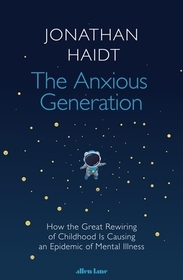
- Publisher's listprice GBP 55.00
-
26 276 Ft (25 025 Ft + 5% VAT)
The price is estimated because at the time of ordering we do not know what conversion rates will apply to HUF / product currency when the book arrives. In case HUF is weaker, the price increases slightly, in case HUF is stronger, the price goes lower slightly.
- Discount 20% (cc. 5 255 Ft off)
- Discounted price 21 021 Ft (20 020 Ft + 5% VAT)
Subcribe now and take benefit of a favourable price.
Subscribe
26 276 Ft

Availability
Estimated delivery time: In stock at the publisher, but not at Prospero's office. Delivery time approx. 3-5 weeks.
Not in stock at Prospero.
Why don't you give exact delivery time?
Delivery time is estimated on our previous experiences. We give estimations only, because we order from outside Hungary, and the delivery time mainly depends on how quickly the publisher supplies the book. Faster or slower deliveries both happen, but we do our best to supply as quickly as possible.
Product details:
- Publisher Bloomsbury Publishing (UK)
- Date of Publication 10 July 2025
- Number of Volumes Hardback
- ISBN 9781440880353
- Binding Hardback
- No. of pages200 pages
- Size 238x158x18 mm
- Weight 484 g
- Language English 669
Categories
Long description:
This resource uses evidence-based documentation to examine the veracity of claims and beliefs about the state, nature, and extent of media bias in American news media, including social media, television, radio, newspapers, magazines, and other media outlets.
The book provides students and other readers with a clear and accurate understanding of claims of media bias (both conservative and liberal) in the United States by refuting falsehoods, misunderstandings, and exaggerations surrounding this topic - and confirming the validity of other assertions. In addition, this sourcebook examines claims and assertions about media bias in other realms of American life, from popular entertainment to social media platforms.
Media Bias: Examining the Facts has been specifically crafted to give readers the tools for a fuller and more accurate understanding of the facts surrounding controversial issues, policies, and laws that occupy center stage in American life and politics. Specific areas of focus in this volume include defining and understanding conscious and unconscious bias; the evolution of the news industry and partisan news sources in the digital age; the ways in which political polarization exacerbates media bias, laws and practices that govern the operations of news media; and clear examples of conservative and liberal bias in such media sectors as cable and broadcast news, radio, newspapers and magazines, talk radio, and online platforms.
Table of Contents:
How to Use This Book
1. The Nature of Bias
Q1. What does it mean to be biased?
Q2. How prevalent is political bias in major media outlets?
Q3. Is bias always a bad thing for consumers of news and information?
Q4. Why have many media outlets seemed to grow increasingly biased over recent years?
Q5. What is a so-called bias of omission?
Q6. When is there a difference between bias and things like disinformation or propaganda?
Q7. Is there any way to measure the accuracy or fairness of news?
2. Mass Media, Politics, and Culture
Q8. How did the development of mass media impact American politics?
Q9. How did the development of the so-called adversarial press shape perceptions of bias?
Q10. How did the corporatization of media change the ways in which news and information are disseminated?
Q11. Is media bias responsible for today's extreme political polarization?
Q12. Are there differing levels of bias in different types of media (print, TV, online)?
3. Opinions and Editorialization
Q13. What is the importance of op-ed pieces in newspaper outlets?
Q14. How important is it when media outlets endorse partisan candidates running for office?
Q15. How carefully do media outlets distinguish between facts and opinions in their content?
Q16. Who decides which news events and stories receive the most attention?
Q17. What is fake news?
4. Liberal Bias
Q18. Is the frequent conservative charge of liberal media bias in mainstream news accurate?
Q19. How biased are cable news stations like CNN and MSNBC or newspapers like the New York Times or Washington Post?
Q20. How have liberal conspiracy theories tainted the presentation of news?
Q21. Is there liberal bias built into the algorithms used by giant tech firms like Facebook, Twitter, and Google?
5. Conservative Bias
Q22. What explains the dominance of Fox News Channel on cable TV?
Q23. How biased are newspapers like the Wall Street Journal or New York Post?
Q24. How have conservative conspiracy theories tainted the presentation of news?
Q25. How influential have far-right or alt-right media outlets been vis-ï¿1⁄2-vis talk radio, podcasts, and various online forums?
6. Governance, Regulations, and Reforms
Q26. Why do some countries have a state-run media?
Q27. What is the job of the FCC when it comes to content moderation or censorship?
Q28. What is the so-called Fairness Doctrine?
Q29. What is the rationale behind calling for the social media giants to be regulated and/or broken up?
Q30. How does Section 230 offer protections for media companies and how has it shaped political bias on the internet?
Q31. What can consumers of news do to help foster competent and balanced presentations of news in the future?
Index


Flames of Fear: The Great Chicago Fire of 1871
2 796 HUF
2 572 HUF

Baseball and the Sultan of Swat: Babe Ruth at 100: Babe Ruth At 100
64 286 HUF
59 143 HUF

The Anxious Generation: How the Great Rewiring of Childhood Is Causing an Epidemic of Mental Illness
11 943 HUF
10 152 HUF







